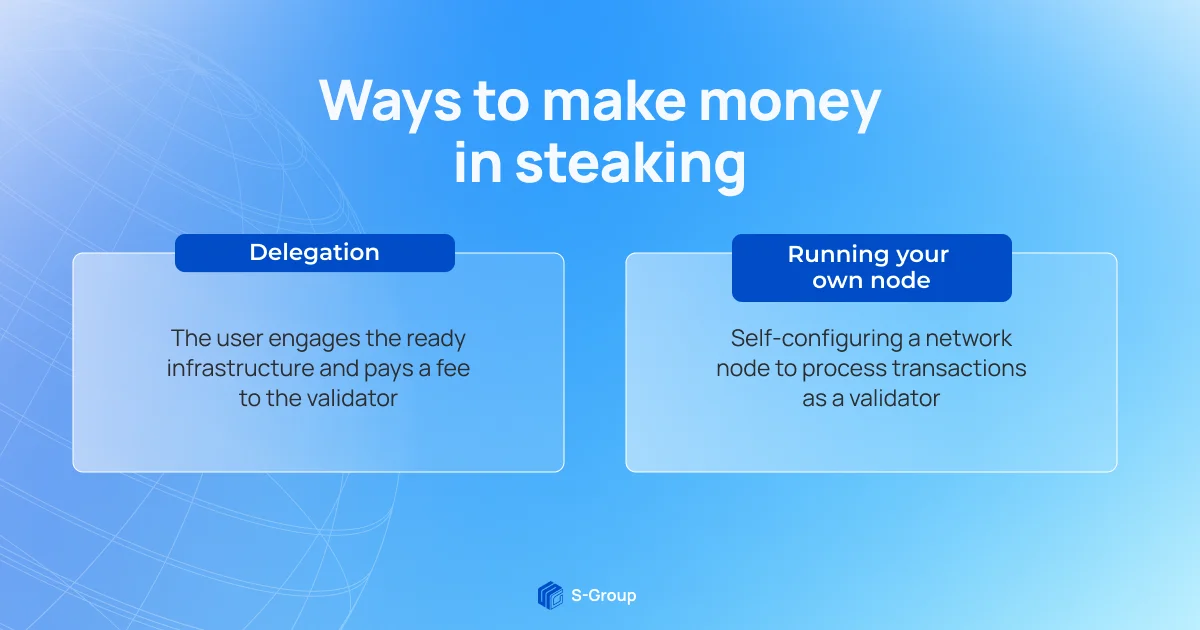The best coins for staking

Staking refers to passive earnings on cryptocurrencies, which works on the proof-of-stake algorithm. In order to multiply capital, an investor needs to freeze assets in the account for some time. In terms of the scheme of work, staking is very similar to a deposit in the bank.
The easiest way to earn money with shaking is delegation, where the user uses the existing infrastructure and pays a fee to the validator. Someone who has his own node (network node) in the cryptocurrency network.
A more complicated but profitable way is to run your own node. It implies an independent configuration of a network node to process transactions in the network as a validator. Thus, a person can not only make money on shaking, but also take an additional fee per transaction from the participants of the shaking pools.

Top 9 coins for staking in 2021
Ethereum (ETH)
Ethereum is the second most popular and capitalized cryptocurrency, which will soon switch from the proof-of-work algorithm to proof-of-stake. It is considered more environmentally friendly because it does not require powerful hardware like proof-of-work. Although the PoS version of the cryptocurrency has not yet been launched, users can take part in staking.
The ether coins they earn will be frozen in their accounts until the official launch of the updates. Yields range from 5% to 7% per annum.
Tezos (XTZ)
An open blockchain protocol for assets and applications that runs on the PoS algorithm, which allows investors to earn on staking. Investors who participate in stacking can make suggestions and improve the Tezos network.
The protocol supports smart contracts (software code that tracks the execution of transaction terms) and enables the development of applications on the blockchain. The yield is 6% per annum. You will need from 8,000 XTZ to start stacking.
Cosmos (ATOM)
The Cosmos project is called the blockchain internet, whose goal is to make all networks interoperable. It is a new type of platform where startups can create their own blockchains. The ATOM platform's cryptocurrency is the 25th largest by market capitalization. Stacking yields are 9.7% per annum. To start earning, you need to have 0.05 ATOM or more.
The Cosmos network can interact with the following major blockchains: Binance Smart Chain, Band Protocol, IRISNet, Kava, Ki Chain, Oasis Protocol, OKEX Chain, Persistence, Polygon, and many others.
Polkadot (DOT)
A unique decentralized platform where different blockchain networks can communicate with each other. The cryptocurrency platform DOT entered the market in 2020, and since then its value has risen from $2.72 to $40.15.
The amount of cryptocurrency it takes to become a validator ranges from 30 to 80 coins. The yield is 14% per annum.
Algorand (ALGO)
The network launched in 2019 to work with financial and banking institutions. Algorand runs on a modified version of PoS — Pure Proof-of-Stake, which features an increased level of decentralization. The network does not require validators to have numerous coins in the account. All it takes is 1 ALGO to run a staking.
The yield of ALGO staking is between 5% and 10% per annum. Coin stacking does not require freezing of assets in the account — the user can withdraw the coin and sell it at any time.
Cardano (ADA)
A project that was developed by Charles Hawkinson, one of the founders of the Ethereum network. The cryptocurrency network ADA, unlike Ethereum, was immediately developed on the PoS algorithm. According to AdaStat, there are 515,813 users involved in the coin's stacking.
About 73% of all issued coins are frozen on the network. Therefore, ADA is the leader in terms of the volume of coins in staking. To start staking, you need to join a pool or start your own. There are over 2,000 pools in the network and the number is increasing all the time. Participants receive remuneration for staking ADA every 20 days. Yield — 7.24% per annum.
Terra (LUNA)
A blockchain protocol used to create stabelcoins tied to fiat currency (regular money). This is how Terra solves the problem of exchange rate volatility. There are two cryptocurrencies in the network: Terra stablecoins secured by fiat currencies and LUNA — a coin that stabilizes the Terra exchange rate and participates in staking. Since the beginning of 2021, the price of the coin has risen 26 times to $17.39. Staking yields are 10.65% p.a.
Tron (TRX)
An entire ecosystem with video hosting, social networking, streaming and payment platforms, a gaming portal and online publishing. Tron helps develop the entertainment sphere, gives excellent tools for creating and promoting blockchain games.
SWP A service token of the S-Wallet ecosystem, created in compliance with the BEP20 standard in the Binance Smart Chain network. SWP token holders can pay transaction fees in the ecosystem, receive additional discounts, and take advantage of a number of other S-Wallet ecosystem products. Opportunities for SWP token holders: - Participation in S-PAD. - Discounts on fees for individual users - Discounts on commissions for corporate users - Participation in the Lending Platform All S-Wallet registered users without a limit in the number of transactions can participate in the SWP Stacking Program. The rate of return of the SWP Staying Platform varies from 60 to 80%. Funds can be deposited for 30/60/90 days.
The advantages of staking
1. Bitcoin mining consumes more electricity than Switzerland. Unlike the proof-of-work algorithm, PoS does not require huge computing power. You only need a certain number of coins in your account.
2. No need to go through KYC (know your customer) and AML (anti-money laundering) identification procedures, which simplifies the process of making money from cryptocurrencies.
Large choice of coins for stacking. Each system has its own conditions and percentages of profitability, so you can choose the best option.
Conclusion
The cryptocurrency market is a tangible competition to the banking system. The annual yield of most staking coins outpaces the benefits of deposits in banks. The eco-friendliness of PoS blockchains surpasses not only the PoW algorithm, but also the banking sector due to their energy costs for maintenance.
Stacking is attracting more and more investors with the opportunity to earn passive income without much effort. Even beginners can place their assets with minimal risk. We are confident that the popularity of staking will grow and PoS coins will become even more popular.
We wrote more details about staking and staking pools in our past articles.
One of the main advantages of Tron is its high transaction speed. The network processes about 2,000 transactions per second. TRX issuance is limited — a total of 100 billion coins have been issued. Staking yields are 4-9% per annum.
Share
Interesting
Would you like to receive a digest of articles?
One email with the best articles of the week.
Sign up so you don't miss anything.